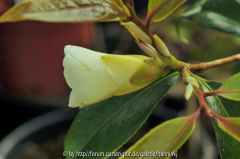Hallo Violatricolor

,der Rhodo ist mir auf einer Gartenausstellung über den Weg gelaufen

und die Tarokaja blüht englisch

toller Erfolg, dein

Sämling von Butterfly Wings sieht klasse aus

Hallo Alle

oder guten Morgen, smile

bei mir blühen gerade die ersten Higo´s und die Dewatairin (japonica oder higo




- danke Jule, werd´s gleich mal nachlesen



nachtrag aus dem Kamelienregister:
Dewatairin.(Large flowering camellia from Dewa Province), (Higo). Itô, Ihei, 1695, Kadan Chikinshô:Described as resembling Shikamura. Yashiro, 1841, Kokon Yôrankô, vol.306. Usamai, Naohachi,(ca.1910), Nagoya Chinzu’e where it is described as “Large, red.” It has not been confirmed that theseold cultivars are the same as the modern Dewatairin. Adachi, 1960, Camellia. Its Appreciation andArtistic Arrangement, p.71, colour pi., p.57 as ‘Taiheiraku’: Light rose pink. Large, 13 cm across,single Higo form, often with a mass of white to pink petaloids in the centre. Early flowering. Stamensnumber in excess of 100. Leaves, large, long-ovate, thinly lustrous, recurved; sometimes yellowvariegated. Synonyms: ‘Daitairin’, ‘Pink Fimbriata’, ‘Golden Temple’, ‘Bar None’, ‘Daihassu’,‘Hatsusakura’, ‘Hatsu-zakura’, ‘Taiheiraku’. ‘Osakazuki’, ‘Taihai’ and, invalidly, ‘Hinomaru’.Originated in Sofue-chô, Aichi Prefecture, Japan. Colour illustations have been published in:Encyclopedia of Camellias in Colour, vol.I, 1972, pl.30, p.48; Tuyama, 1968, Camellias of Japan,pl.286, p.144, 177 & 295. Hiratsuka, 1964, Higo Camellia as ‘Taihei-raku’; Seibundô Shinkôsha,1979, Senchinshû, p.85 as ‘Taiheiraku’ and p.102 as ‘Dewatairin’. Macoboy, 1981, The ColourDictionary of Camellias, p.136. Yokoyama & Kirino, 1989, Nihon no Chinka, p.246 erroneouslyillustrates the variegated form as ‘Dewa-tairin’. Received the RHS. “Award of Merit”, 1953 as‘Hatsu-Sakura’. The white variegated form is named Manzairaku.und hier noch ein kleiner auszug aus dem
AMERICAN CAMELLIA YEARBOOK 1956The publication, Camellia Varieties in Japan is modeled afterThe Camellia, Its Culture and Nomenclature of the Southern Cali-fornia Camellia Society.It gives 411 names of camellias grown in Japan. Some of these are synonyms. The short descriptions cover color, size, form and season. Type of growth (upright, bushy, etc.)and adaptation (shade, sun, pot-culture, etc.) also is given for mostvarieties.
A special group of interesting camellias, called Higo-camellias, mostly single, with widely flared stamens is set up. This group in the United States is represented by such varieties as Amabilis, Daitairin and Pink Poppy. There also is a list of varieties belonging to the hardy rusticana group, snow camellias. Japonica

Higo

- ich hab sie umgetauft in Camellia



,wäre interessant mal ein Originalbild aus der Dewa Province zu finden,um sie zu vergleichen, ob es sich doch um die alte Zuchtform

oder um eine neuere Züchtung handelt. werd mal "google" füttern ....

.schau mal Violatricolor, die Lipstick

hat auch endlich hier die erste Blüten geöffnet

Hallo soso

,die weiße könnte eine Alba Plena sein

Hallo Cornishsnow

,wünsche Dir einen schönen Urlaub und viele Kamelien die dir über denWeg laufen, damit wir hier auch ein paar Bildereindrücke bekommen

lgKlunkerfrosch


 nachtrag aus dem Kamelienregister:Dewatairin.(Large flowering camellia from Dewa Province), (Higo). Itô, Ihei, 1695, Kadan Chikinshô:Described as resembling Shikamura. Yashiro, 1841, Kokon Yôrankô, vol.306. Usamai, Naohachi,(ca.1910), Nagoya Chinzu’e where it is described as “Large, red.” It has not been confirmed that theseold cultivars are the same as the modern Dewatairin. Adachi, 1960, Camellia. Its Appreciation andArtistic Arrangement, p.71, colour pi., p.57 as ‘Taiheiraku’: Light rose pink. Large, 13 cm across,single Higo form, often with a mass of white to pink petaloids in the centre. Early flowering. Stamensnumber in excess of 100. Leaves, large, long-ovate, thinly lustrous, recurved; sometimes yellowvariegated. Synonyms: ‘Daitairin’, ‘Pink Fimbriata’, ‘Golden Temple’, ‘Bar None’, ‘Daihassu’,‘Hatsusakura’, ‘Hatsu-zakura’, ‘Taiheiraku’. ‘Osakazuki’, ‘Taihai’ and, invalidly, ‘Hinomaru’.Originated in Sofue-chô, Aichi Prefecture, Japan. Colour illustations have been published in:Encyclopedia of Camellias in Colour, vol.I, 1972, pl.30, p.48; Tuyama, 1968, Camellias of Japan,pl.286, p.144, 177 & 295. Hiratsuka, 1964, Higo Camellia as ‘Taihei-raku’; Seibundô Shinkôsha,1979, Senchinshû, p.85 as ‘Taiheiraku’ and p.102 as ‘Dewatairin’. Macoboy, 1981, The ColourDictionary of Camellias, p.136. Yokoyama & Kirino, 1989, Nihon no Chinka, p.246 erroneouslyillustrates the variegated form as ‘Dewa-tairin’. Received the RHS. “Award of Merit”, 1953 as‘Hatsu-Sakura’. The white variegated form is named Manzairaku.und hier noch ein kleiner auszug aus dem
nachtrag aus dem Kamelienregister:Dewatairin.(Large flowering camellia from Dewa Province), (Higo). Itô, Ihei, 1695, Kadan Chikinshô:Described as resembling Shikamura. Yashiro, 1841, Kokon Yôrankô, vol.306. Usamai, Naohachi,(ca.1910), Nagoya Chinzu’e where it is described as “Large, red.” It has not been confirmed that theseold cultivars are the same as the modern Dewatairin. Adachi, 1960, Camellia. Its Appreciation andArtistic Arrangement, p.71, colour pi., p.57 as ‘Taiheiraku’: Light rose pink. Large, 13 cm across,single Higo form, often with a mass of white to pink petaloids in the centre. Early flowering. Stamensnumber in excess of 100. Leaves, large, long-ovate, thinly lustrous, recurved; sometimes yellowvariegated. Synonyms: ‘Daitairin’, ‘Pink Fimbriata’, ‘Golden Temple’, ‘Bar None’, ‘Daihassu’,‘Hatsusakura’, ‘Hatsu-zakura’, ‘Taiheiraku’. ‘Osakazuki’, ‘Taihai’ and, invalidly, ‘Hinomaru’.Originated in Sofue-chô, Aichi Prefecture, Japan. Colour illustations have been published in:Encyclopedia of Camellias in Colour, vol.I, 1972, pl.30, p.48; Tuyama, 1968, Camellias of Japan,pl.286, p.144, 177 & 295. Hiratsuka, 1964, Higo Camellia as ‘Taihei-raku’; Seibundô Shinkôsha,1979, Senchinshû, p.85 as ‘Taiheiraku’ and p.102 as ‘Dewatairin’. Macoboy, 1981, The ColourDictionary of Camellias, p.136. Yokoyama & Kirino, 1989, Nihon no Chinka, p.246 erroneouslyillustrates the variegated form as ‘Dewa-tairin’. Received the RHS. “Award of Merit”, 1953 as‘Hatsu-Sakura’. The white variegated form is named Manzairaku.und hier noch ein kleiner auszug aus dem Hallo soso
Hallo soso